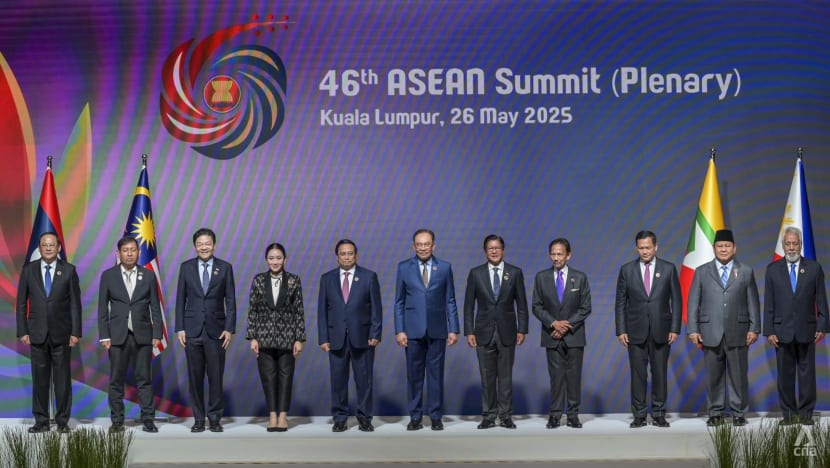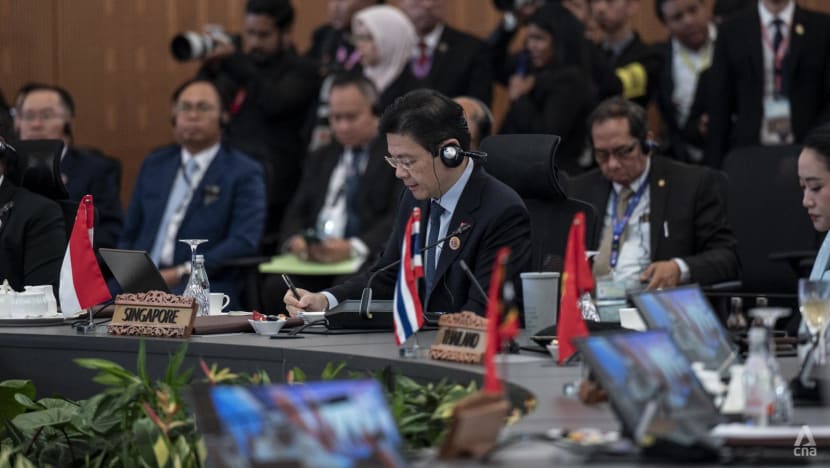analysis Asia
First ASEAN-Gulf bloc-China summit 'ambitious', but competing interests pose partnership challenge
The three sides need to iron out differences in development as well as strategic priorities in areas such as dependence on the US, analysts say.

Chinese Premier Li Qiang giving his opening remarks during the ASEAN-GCC-China Summit in Kuala Lumpur on May 27, 2025. (Photo: CNA/Fadza Ishak)

This audio is generated by an AI tool.
KUALA LUMPUR: The historic summit this week between ASEAN, China and a Gulf bloc marked a "symbolically significant and ambitious" hedge against rising global uncertainty in the face of United States tariffs, analysts said.
But they added that the inaugural meeting between leaders of the Association of Southeast Asian Nations (ASEAN), Gulf Cooperation Council (GCC) and the East Asian superpower also laid bare the three sides' competing interests as they seek to find common ground without alienating ties with Washington.
While the summit in Kuala Lumpur did not produce immediate breakthroughs, it was still a valuable platform for the three parties to clarify each other’s priorities and explore urgent methods of cooperation amid growing global fragmentation, the experts said.
“In this context, both ASEAN and GCC countries are among China’s most important trading partners, and their positions will be critical as Beijing strategises its response to evolving US trade pressures,” said Li Yao, a senior research fellow at the National University of Singapore’s East Asian Institute.
But the challenge is how the sides navigate these diverging priorities and a developmental gap in a trilateral partnership spanning 17 countries, all while keeping their relationships with the US on an even keel, the analysts said.
The GCC - comprising Saudi Arabia, the United Arab Emirates (UAE), Qatar, Kuwait, Bahrain and Oman - has close ties with the US.
US President Donald Trump got lavish receptions across Saudi Arabia, Qatar and UAE during his recent Middle East tour earlier in May, before securing hundreds of billions of dollars of investment commitment from the three countries.
The ASEAN-GCC-China Summit might have purposefully avoided any overtly anti-US language, but the optics of a trilateral meeting involving Beijing - especially amid tariff tensions - could still raise concerns in Washington, the analysts told CNA.
Under the second Trump administration, there is a higher risk that such partnerships could be interpreted as undermining US influence, said Joanne Lin, senior fellow and co-coordinator of the ASEAN Studies Centre at Singapore’s ISEAS-Yusof Ishak Institute.
"For a first-of-its-kind summit, the ASEAN-GCC-China meeting was symbolically significant and ambitious," Lin told CNA.
The summit showed an intent to "deepen South-South cooperation, broaden economic partnerships and present a more autonomous front" amid rising global uncertainty, particularly in the face of US tariffs, but this is not without challenges, she said.
"The interests and priorities of ASEAN, the GCC and China are not entirely the same or aligned," Lin said, adding that she heard the ASEAN-GCC-China joint statement eventually issued on Wednesday morning was one of the "most difficult" statements that had to be negotiated this summit season.
"ASEAN is more focused on practical cooperation, the GCC is increasingly seeking space to assert its Middle East priorities, while China is leveraging the platform to advance its global ambitions and influence."
.jpg?itok=p1EbWoi8)
The ASEAN-GCC-China Summit, is the brainchild of Malaysian Prime Minister Anwar Ibrahim and marks the first such summit between ASEAN, one of its dialogue partners, and a third multilateral grouping.
At the summit, several leaders in their opening remarks pledged to build a new model of cooperation against a backdrop of an “increasingly complex” global environment.
In the summit’s joint statement, the three parties agreed to improve economic cooperation and work more closely together in areas such as connectivity, energy security, digital transformation, food and agriculture, as well as people-to-people exchanges.
The statement made sure to highlight the importance of upholding ASEAN’s “centrality in the evolving regional architecture”, and the GCC’s and China’s roles in promoting “peace” and “stability”. It did not mention the US or its unilateral levies.
Geopolitical trust deficits among the sides remain a "major constraint", Li said, pointing to how the South China Sea disputes, for example, continue to shape perceptions of China’s regional intentions, with some ASEAN countries expressing stronger concerns than others.
China claims most of the strategic and resource-rich waterways as its own, while several ASEAN members including the Philippines have overlapping claims.
"Similarly, historical tensions and regional rivalries in the Middle East may influence how GCC members approach multilateral cooperation involving China and ASEAN," Li said.
"Therefore, while the trilateral partnership holds potential, its effectiveness will hinge on managing the diverse interests, strategic calculations, and levels of mutual trust among participating countries."
DEVELOPMENT GAPS, COMPETING INTERESTS
The varying levels of development among ASEAN member states have long posed internal challenges, particularly in reaching consensus on sensitive issues such as environmental standards, labour rights, and streamlining regulations, Li said.
“These disparities are likely to carry over into the broader ASEAN-GCC-China partnership, complicating efforts to formulate cohesive policies across such a diverse grouping,” she said.
Lin said the developmental gaps could shape the pace and scope of cooperation in the trilateral partnership.
“Some ASEAN countries still face basic infrastructure and governance challenges, while others like Singapore and China are pushing into advanced tech and finance. Meanwhile, the GCC states are navigating their own transitions away from oil dependence,” she said.
Within the ASEAN-GCC-China partnership, Li said differences in economic structure and varying degrees of reliance on the US market and security architecture would introduce further limitations.
“Some countries are more deeply integrated into the US-led global supply chains or depend on American security guarantees, making them less willing to pursue initiatives that might be perceived as drifting too close to China,” she said.
“As a result, the political space for manoeuvre will differ significantly across the group, affecting the depth and pace of trilateral cooperation.”

All parties in the trilateral partnership - including China - would prefer strong economic ties with the US, said Ruby Osman, geopolitics policy advisor at the Tony Blair Institute for Global Change, which helps governments with policy and strategy.
“But the summit still represents an implicit criticism of the US's increasingly unilateral - and transactional - approach to global trade,” she said.
The summit could make Washington reassess its approach to bilateral tariff talks based on the evolving dynamics among its traditional partners and strategic competitors, Li said, noting that Trump has demonstrated “a degree of flexibility and transactional pragmatism” in past negotiations.
But Osman said the US is unlikely to be worried about a trilateral joint response to the tariffs, given its varied trade relationships across the Gulf and Southeast Asia, citing how GCC countries were comparatively unscathed while ASEAN nations were initially among the hardest hit.
While Gulf countries such as the UAE, Qatar and Saudi Arabia were subject to a baseline tariff of 10 per cent, some Southeast Asia nations such as Cambodia and Laos were hit by tariff threats of 49 per cent and 48 per cent respectively, before Trump announced his 90-day pause on Apr 9.
However, the US “might pay more attention to any emerging collaboration (between ASEAN, GCC and China) on AI and digital infrastructure,” said Osman.
“China and the US are increasingly turning their attention to the race not just to develop but to diffuse artificial intelligence solutions globally, and both ASEAN and the GCC will be key markets to build influence,” she added.
COOPERATION BEYOND TRADE
The ASEAN-GCC-China partnership promises avenues for broader trilateral cooperation beyond traditional trade, Li said.
“China holds notable strengths in digital infrastructure, green technologies and supply chain coordination - areas it can leverage not only to expand economic influence but also to counteract potential ‘poison pill’ provisions embedded in future US trade agreements with third parties,” she said.
“Through collaboration in these sectors, ASEAN and GCC countries may benefit from access to technology, investment, and diversified trade routes, thereby strengthening their economic autonomy.”
Poison pills are clauses that could limit deeper engagement with China, Li said, something Beijing is increasingly concerned about.

Lin said the summit could unlock meaningful cooperation across key areas like energy, infrastructure, digital connectivity and the green transition, all of which are priorities for ASEAN, the GCC and China.
“For ASEAN, it’s also a strategic opportunity to leverage Gulf countries' and China’s implementation capacity to bridge regional development gaps,” she added.
“There were also discussions about the Gulf states potentially joining the Regional Comprehensive Economic Partnership (RCEP), which, if realised, would significantly broaden ASEAN’s trade ecosystem.”
The ASEAN-driven RCEP is the world’s largest free trade agreement (FTA), comprising about 30 per cent of the world’s total gross domestic product and population. It is made up of the 10 ASEAN countries as well as Australia, China, Japan, South Korea and New Zealand.
“VERY AMBITIOUS” FREE TRADE AGREEMENTS
During the summit, Singapore Prime Minister Lawrence Wong had broached working towards an ASEAN-GCC-China FTA “in due course”, while also suggesting an "ambitious plan" to develop a partnership between GCC and RCEP.
Both ASEAN and China are in separate talks to each sign an FTA with the GCC, while ASEAN already has an FTA with China.
ASEAN, the GCC and China together represent a combined gross domestic product of US$24.87 trillion and a population of approximately 2.15 billion, with their leaders keen to stress the vast untapped potential.

Lin said the idea of a trilateral FTA is “bold but not impossible”.
“However, bringing all three together will be a tall order, mainly due to differences in regulatory regimes, trade standards and economic openness,” she said.
“Some GCC economies still maintain high barriers in certain sectors, and ASEAN itself isn’t a single market. Political will is there, but the technical and strategic hurdles remain significant.”
Lin also described the suggestion of including the GCC in RCEP as “forward-looking”, one that would “significantly expand” RCEP’s reach and underscore its role as a global trading platform.
“But any move in that direction will require detailed feasibility studies,” she added.
Adib Zalkapli, a geopolitical analyst specialising in the Indo-Pacific, said such partnerships were “very ambitious, but given the current climate, it makes a lot of economic sense”.
“Given the challenges and disruptions to global trade caused by (Trump’s) Liberation Day tariffs, it makes strategic sense to leverage existing frameworks like RCEP as a defensive mechanism,” the managing director of Viewfinder Global Affairs said.
Trilateral FTAs are also “not entirely unusual”, he said, citing the existing ASEAN-Australia-New Zealand FTA and the North American FTA between Canada, Mexico and the US.
“But like any FTA, the negotiations can be time-consuming and labour-intensive,” he said.
Adib said the nature of the ASEAN-GCC-China Summit, involving high-level discussions, means it is not expected to produce tangible outcomes overnight.
“The trilateral summit should not be taken as a sign that ASEAN is tilting towards China. The best response from the US is to be more actively engaging with ASEAN,” he added.
“Convening the summit itself is a success in a way. What is more important is to see in the coming years, efforts by the three parties to operationalise the aspirations or objectives of the summit.”


















